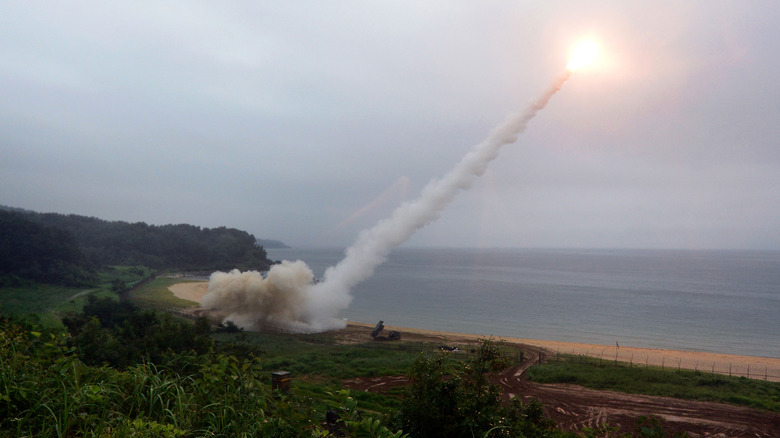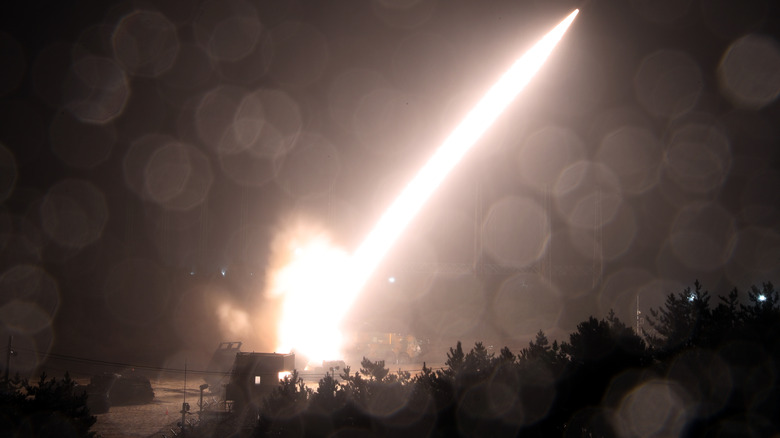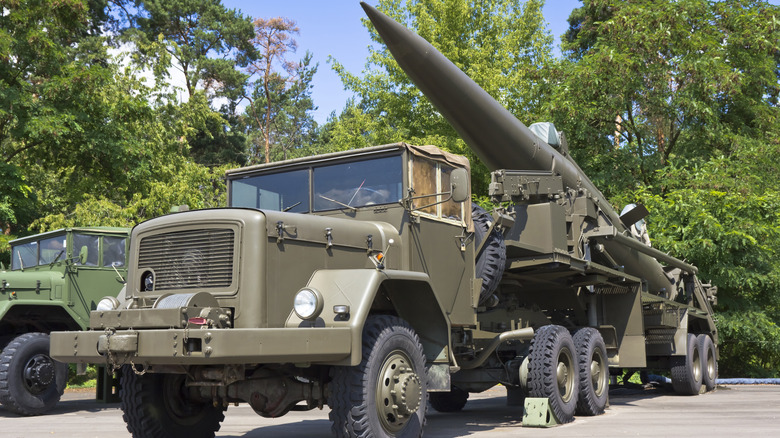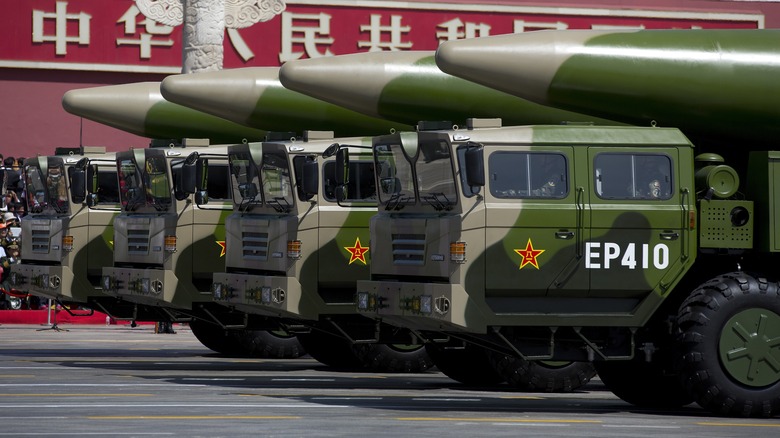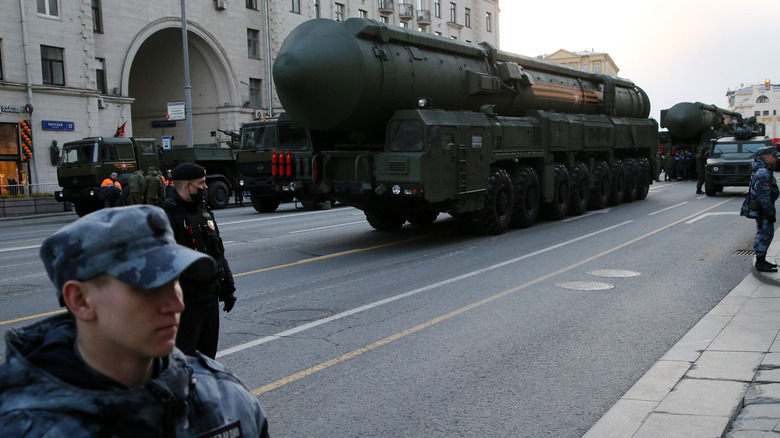Ballistic Missile Types: A Guide To The Big 4
Unlike cruise missiles — which can travel close to the ground, are hard to detect, and can use GPS or be manually guided toward their marks — ballistic missiles are instead fired high into the air before falling unpowered back down toward their intended targets. Initial propulsion into the sky is done by rockets that use either solid or liquid fuel, and ballistic missiles have three stages of flight. The first stage is the boost phase as the rocket is firing, while the second and third are the unpowered stages in which the rocket still continues upward (midcourse phase) before coming down (terminal phase). Some ballistic missiles can travel up to 15,000 mph, though the speeds and ranges of missiles vary from type to type.
In fact, ballistic missiles are generally classified into four different categories based on their range: short-range, medium-range, intermediate-range, and intercontinental. During the Cold War, the U.S. and Soviet Union manufactured thousands of ballistic missiles, with many still operational today. While they are very powerful and dangerous and even nuclear capable, they're not foolproof — the U.S. and some allies use the Patriot Air Defense System and the Arrow 3 Anti-Ballistic Missile Defense System as a shield against them.
Ballistic missiles are unfortunately very much in the news lately, as they've been recently used by both sides in the Russo-Ukrainian War. Ukraine is even alleging that, in November 2024, Russia became the first country to use an intercontinental ballistic missile (ICBM) in an armed conflict. However, Russia is claiming that the missile is actually a medium-range ballistic missile. At the time of writing, it's still unclear what type of ballistic missiles are being used in the conflict. Nevertheless, here's a guide to the four types of ballistic missiles.
Short-range ballistic missiles
Short-range ballistic missiles (SRBMs) are classified as those with a range that's less than 1,000 kilometers (about 620 miles). SRBMs are known as tactical missiles and can also be classified as theater ballistic missiles. Because of their shorter range, they are typically used more frequently than longer-range missiles and have been deployed in numerous regional conflicts, including the Iran-Iraq War and Persian Gulf War. Many countries include SRBMs in their armaments, including Belarus, Egypt, India, Slovakia, Turkmenistan, and Yemen.
One infamous SRBM is the Scud missile, which was originally developed by the Soviet Union shortly after the end of World War II. Still in use by several nations, the Scud has a range of 190–550 km and can theoretically carry nuclear payloads, though larger military forces like that of Russia have replaced Scuds with more modern SRBMs. These modern Russian SRBMs include the 9K720 Iskander and the OTR-21 Tochka, which are road-mobile and can quickly be deployed on and near battlefields. Both have been used in the current Russo-Ukrainian War. The Iskander has a range of 400–500 km and has a payload of 480–700 kg, enough to carry high-explosive, submunition, earth-penetrator, and thermobaric warheads. The Tochka — also known as the Scarab — has a much shorter range (70-120 km) and can carry a single warhead up to 482 kg, though that warhead can be nuclear or chemical, making it a very deadly weapon.
The U.S. also currently uses SRBMs. The MGM-140 Army Tactical Missile System (ATACMS) was first used in the Persian Gulf War. These missiles are road-mobile and can be launched from vehicles, with a range of up to 300 km. ATACMS can deliver a single warhead up to 560 kg and strike combatants with high-explosive, high-explosive blast fragmentation, or 300-950 submunitions.
Medium-range ballistic missiles
Medium-range ballistic missiles (MRBMs) have a range between 1,000 and 3,000 kilometers (approximately 620-1,860 miles) are also referred to as theater ballistic missiles. One such MRBM is the DF-21, which was developed by China and is currently still in its armament; the only other country known to have the DF-21 is Saudi Arabia. The DF-21 has a range of 2,150 km and — with a 600 kg payload — can carry 250 or 500 kiloton nuclear warheads. With a length of 10.7 meters, the DF-21 can be launched from a road-mobile transporter and uses two-stage solid propellant to reach its target.
The U.S. currently doesn't own any operational MRBMs, which were banned in the 1987 Intermediate-Range Nuclear Forces Treaty signed by the U.S. and Soviet Union. The treaty banned the use of certain ground-based missiles with ranges of 500–5,500 km (310-3,400 miles), which includes MRBMs. However, the U.S. formally withdrew from the INF treaty in 2019, during the first Trump administration, due to a belief that Russia had broken it.
Russian President Vladimir Putin claims to have hit Kyiv, Ukraine with a medium-range ballistic missile on November 21, 2024. Putin said Russian forces were testing the new weapon, called the Oreshnik, and that it carried a non-nuclear hypersonic warhead.
Intermediate-range ballistic missiles
Don't let the word "intermediate" fool you — intermediate-range ballistic missiles (IRBMs) can hit targets significantly far away, as they have a range of 3,000-5,500 kilometers (approximately 1,860-3,410 miles). That's why, like ICBMs, they're classified as strategic ballistic missiles. IRBMs were first developed early in the Cold War and include the PGM-19 Jupiter. The Jupiter was a high priority for President Eisenhower and was originally conceived by Wernher von Braun, the pioneering aerospace and rocket engineer. It was powered by a Rocketdyne S-3D rocket engine that could deliver 150,000 pounds of thrust and carried a single W-49 thermonuclear warhead.
Another obsolete product of the Cold War is the Soviet Union's RSD-10 Pioneer, an IRMB which used two-stage solid propellant and had a range of 5,000 km. It could hold up to three 150 kiloton warheads and was in service until the Intermediate-Range Nuclear Forces Treaty.
A currently-operational IRBM is the DF-26, which, notably, is China's first ballistic missile that can reach the U.S. territory of Guam. That's because it has a range of 4,000 km, and it can carry a nuclear or conventional payload of 1,200–1,800 kilograms. One of the more recently-developed ballistic missiles, the DF-26 is considered to be highly precise.
Intercontinental ballistic missiles (ICBMs)
The fourth type of ballistic missile is the intercontinental ballistic missile (ICBM), which gets its name from its incredible range — they're classified as any ballistic missiles that can go further than 5,500 kilometers (approximately 3,410 miles). With the ability to be fired across the world from one continent to another, it is the symbolic weapon of a global war between the East and West, and is classified as a strategic ballistic missile.
Currently, the U.S. has 450 known operational ICBM silos — located in Wyoming, Montana, and North Dakota. These silos house Minuteman III ICBMs, which make up one-third of the U.S. nuclear triad defense system and are powered by three-stage solid-propellant rockets. They weigh nearly 80,000 pounds each, have a range of over 6,000 miles, and can fly 700 miles into the air before coming back down, with the ability to reach jaw-dropping Mach 23 speeds (roughly 15,000 mph). The last of the 400 operational Minuteman III ICBMs were manufactured in 1978, making them nearly 50 years old — however, guidance systems and other elements of the missiles, including the payloads, have been updated over time. The U.S. plans to decommission and replace its Minuteman III arsenal with still-in-development LGM-35A Sentinel ICBMs; however, it could still be some time before this changing of the guard is completed.
Another newer and deadlier ICBM in development is the DF-41 by China, which could hold up to 10 nuclear warheads and have a range of up to 15,000 kilometers. China currently uses the DF-31, while Russia's operational ICBM is the RS-24 Yars. Both have ranges around 10,000 kilometers and 200 kiloton nuclear capabilities.
